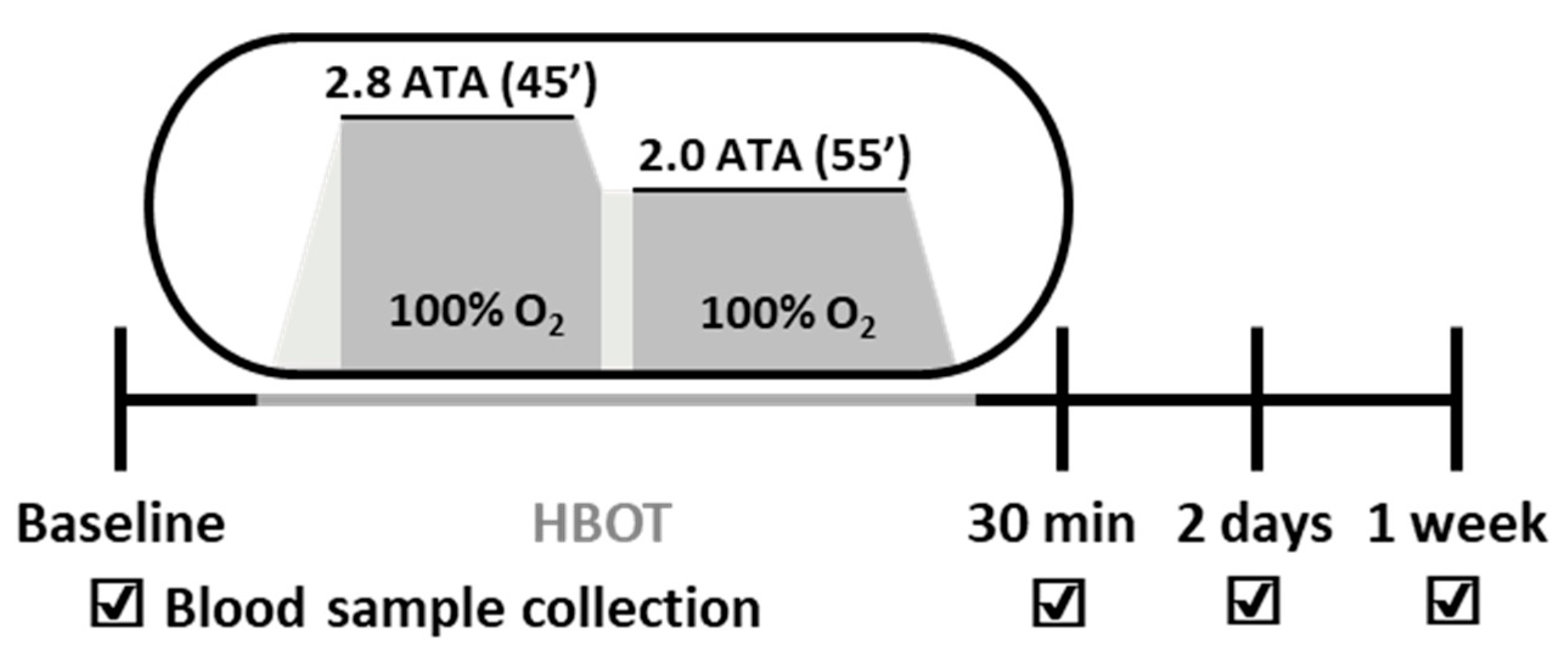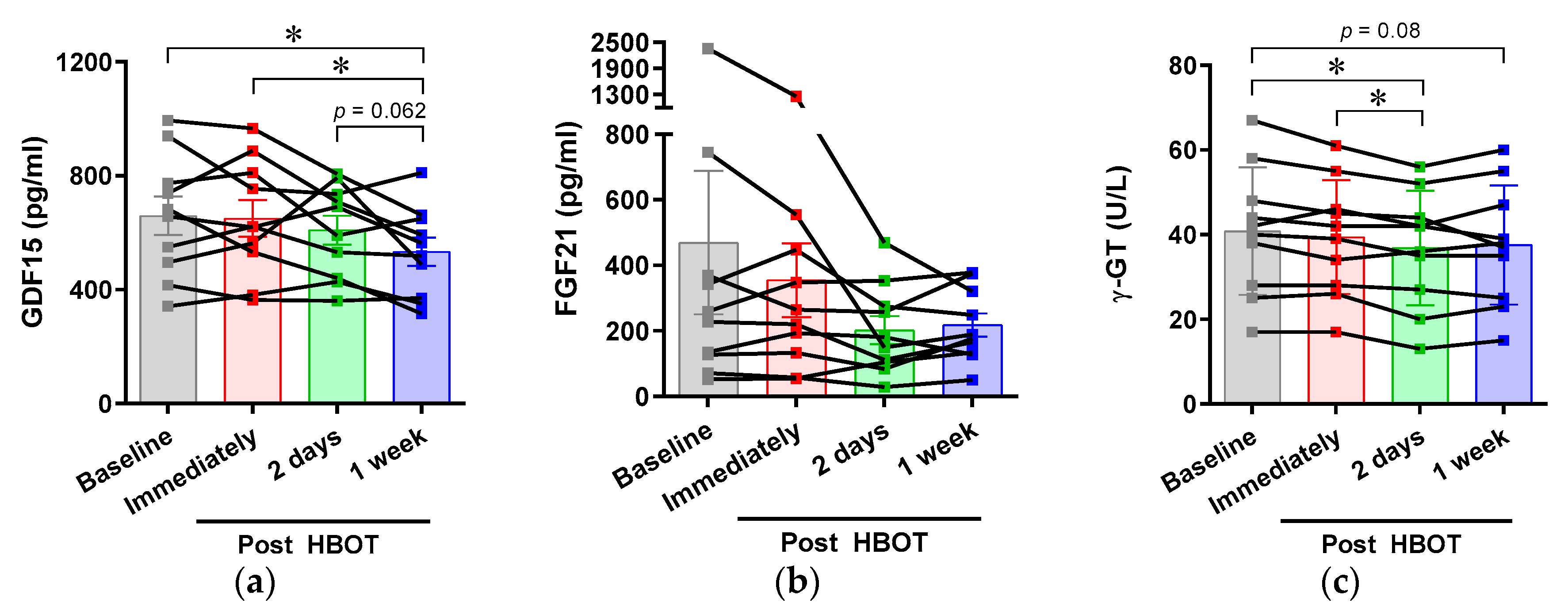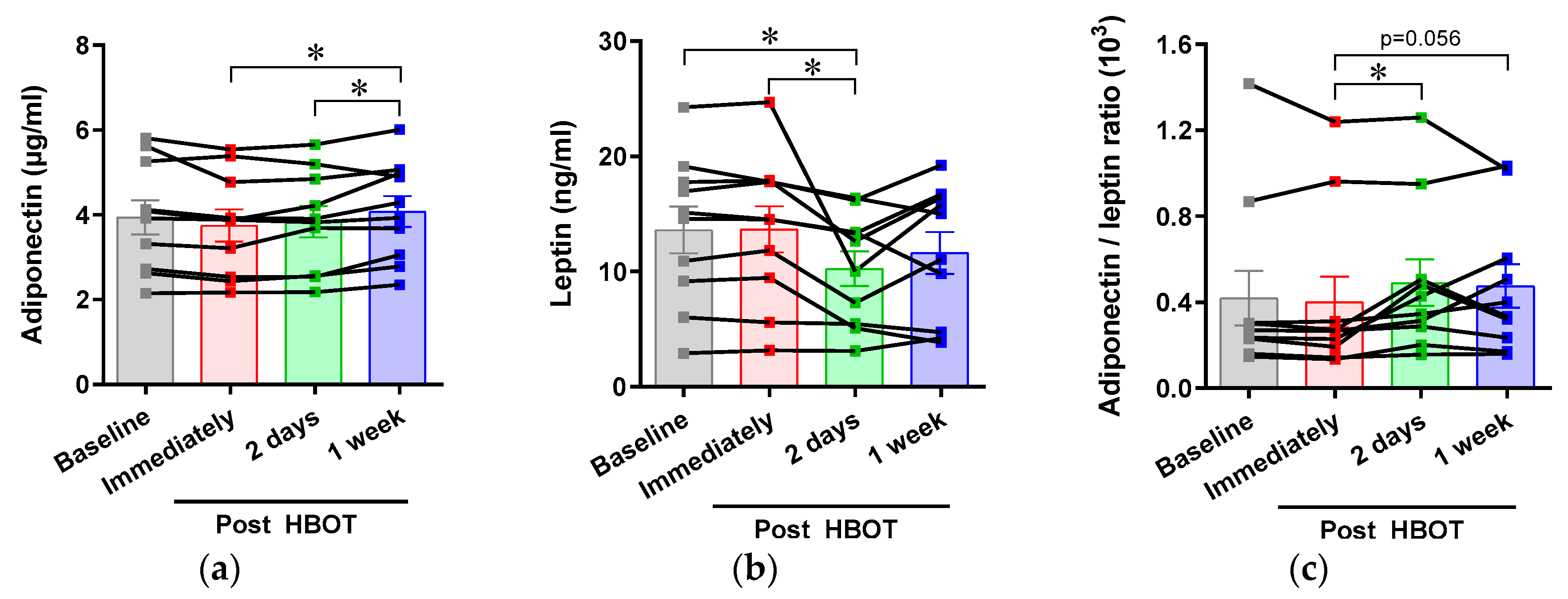Hyperbaric Oxygen Exposure Attenuates Circulating Stress Biomarkers: A Pilot Interventional Study
Abstract
1. Introduction
2. Materials and Methods
2.1. Study Participants and Ethical Approval
2.2. Hyperbaric Oxygen Therapy (HBOT)
2.3. Blood Collection and Biochemical Analysis
2.4. QMAP Assays
2.5. ELISA Assays
2.6. Statistical Analysis
3. Results
4. Discussion
5. Conclusions
Author Contributions
Funding
Acknowledgments
Conflicts of Interest
Appendix A
| GDF15 | FGF21 | γ-GT | Adiponectin | Leptin | A/L | Triglyceride | |
|---|---|---|---|---|---|---|---|
| GDF15 | 1 | ||||||
| FGF21 | 0.214 | 1 | |||||
| γ-GT | −0.023 | 0.453 ** | 1 | ||||
| Adiponectin | 0.065 | 0.072 | 0.305 | 1 | |||
| Leptin | 0.487 ** | 0.115 | 0.325 * | 0.075 | 1 | ||
| A/L | −0.356 * | −0.138 | −0.380 * | 0.323 * | −0.801 ** | 1 | |
| Triglyceride | −0.386 * | 0.018 | 0.163 | −0.23 | −0.072 | −0.07 | 1 |
| ΔGDF15 | ΔFGF21 | Δγ-GT | ΔAdiponectin | ΔLeptin | ΔA/L | ΔTriglyceride | |
|---|---|---|---|---|---|---|---|
| ΔGDF15 | 1 | ||||||
| ΔFGF21 | 0.673 ** | 1 | |||||
| Δγ-GT | 0.539 * | 0.386 | 1 | ||||
| ΔAdiponectin | −0.01 | −0.504 * | 0.17 | 1 | |||
| ΔLeptin | 0.557 ** | 0.317 | 0.737 *** | 0.17 | 1 | ||
| ΔA/L | −0.428 | −0.326 | −0.289 | 0.088 | −0.612 ** | 1 | |
| ΔTriglyceride | 0.244 | −0.053 | −0.309 | 0.031 | −0.069 | −0.423 | 1 |



References
- Veltkamp, R.; Warner, D.S.; Domoki, F.; Brinkhous, A.D.; Toole, J.F.; Busija, D.W. Hyperbaric oxygen decreases infarct size and behavioral deficit after transient focal cerebral ischemia in rats. Brain Res. 2000, 853, 68–73. [Google Scholar] [CrossRef]
- Chen, S.-J.; Yu, C.-T.; Cheng, Y.-L.; Yu, S.-Y.; Lo, H.-C. Effects of hyperbaric oxygen therapy on circulating interleukin-8, nitric oxide, and insulin-like growth factors in patients with type 2 diabetes mellitus. Clin. Biochem. 2007, 40, 30–36. [Google Scholar] [CrossRef] [PubMed]
- Sheikh, A.Y.; Gibson, J.J.; Rollins, M.D.; Hopf, H.W.; Hussain, Z.; Hunt, T.K. Effect of Hyperoxia on Vascular Endothelial Growth Factor Levels in a Wound Model. Arch. Surg. 2000, 135, 1293–1297. [Google Scholar] [CrossRef] [PubMed]
- Ying, X.; Tu, W.; Li, S.; Wu, Q.; Chen, X.; Zhou, Y.; Hu, J.; Yang, G.; Jiang, S. Hyperbaric oxygen therapy reduces apoptosis and dendritic/synaptic degeneration via the BDNF/TrkB signaling pathways in SCI rats. Life Sci. 2019, 229, 187–199. [Google Scholar] [CrossRef] [PubMed]
- Li, J.-S.; Zhang, W.; Kang, Z.-M.; Ding, S.; Liu, W.-W.; Zhang, J.; Guan, Y.-T.; Sun, X. Hyperbaric oxygen preconditioning reduces ischemia–reperfusion injury by inhibition of apoptosis via mitochondrial pathway in rat brain. Neuroscience 2009, 159, 1309–1315. [Google Scholar] [CrossRef] [PubMed]
- Gregorevic, P.; Lynch, G.S.; Williams, D.A. Hyperbaric oxygen modulates antioxidant enzyme activity in rat skeletal muscles. Eur. J. Appl. Physiol. 2001, 86, 24–27. [Google Scholar] [CrossRef]
- Benson, R.M.; Minter, L.M.; Osborne, B.A.; Granowitz, E.V. Hyperbaric oxygen inhibits stimulus-induced proinflammatory cytokine synthesis by human blood-derived monocyte-macrophages. Clin. Exp. Immunol. 2003, 134, 57–62. [Google Scholar] [CrossRef]
- Kim, C.-H.; Choi, H.; Chun, Y.-S.; Kim, G.-T.; Park, J.-W.; Kim, M.-S. Hyperbaric oxygenation pretreatment induces catalase and reduces infarct size in ischemic rat myocardium. Pflügers Arch. 2001, 442, 519–525. [Google Scholar] [CrossRef]
- Kawada, S.; Wada, E.; Matsuda, R.; Ishii, N. Hyperbaric Hyperoxia Accelerates Fracture Healing in Mice. PLoS ONE 2013, 8, e72603. [Google Scholar] [CrossRef] [PubMed]
- Best, T.M.; Loitz-Ramage, B.; Corr, D.T.; Vanderby, R. Hyperbaric Oxygen in the Treatment of Acute Muscle Stretch Injuries. Am. J. Sport. Med. 1998, 26, 367–372. [Google Scholar] [CrossRef]
- Dave, K.; Prado, R.; Busto, R.; Raval, A.; Bradley, W.; Torbati, D.; Pérez-Pinzón, M. Hyperbaric oxygen therapy protects against mitochondrial dysfunction and delays onset of motor neuron disease in wobbler mice. Neuroscience 2003, 120, 113–120. [Google Scholar] [CrossRef]
- Kurt, B.; Kurt, Y.; Karslioglu, Y.; Topal, T.; Erdamar, H.; Korkmaz, A.; Türközkan, N.; Yaman, H.; Odabaşı, Z.; Gunhan, O.; et al. Effects of hyperbaric oxygen on energy production and xanthine oxidase levels in striated muscle tissue of healthy rats. J. Clin. Neurosci. 2008, 15, 445–450. [Google Scholar] [CrossRef]
- Palzur, E.; Zaaroor, M.; Vlodavsky, E.; Milman, F.; Soustiel, J.F. Neuroprotective effect of hyperbaric oxygen therapy in brain injury is mediated by preservation of mitochondrial membrane properties. Brain Res. 2008, 1221, 126–133. [Google Scholar] [CrossRef] [PubMed]
- Suzuki, J. Endurance performance is enhanced by intermittent hyperbaric exposure via up-regulation of proteins involved in mitochondrial biogenesis in mice. Physiol. Rep. 2017, 5, e13349. [Google Scholar] [CrossRef]
- Turner, N.; Heilbronn, L.K. Is mitochondrial dysfunction a cause of insulin resistance? Trends Endocrinol. Metab. 2008, 19, 324–330. [Google Scholar] [CrossRef] [PubMed]
- Ly, L.D.; Xu, S.; Choi, S.-K.; Ha, C.-M.; Thoudam, T.; Cha, S.-K.; Wiederkehr, A.; Wollheim, C.B.; Lee, I.-K.; Park, K.-S. Oxidative stress and calcium dysregulation by palmitate in type 2 diabetes. Exp. Mol. Med. 2017, 49, e291. [Google Scholar] [CrossRef]
- Salminen, A.; Kaarniranta, K.; Kauppinen, A. Integrated stress response stimulates FGF21 expression: Systemic enhancer of longevity. Cell. Signal. 2017, 40, 10–21. [Google Scholar] [CrossRef]
- Davis, R.L.; Liang, C.; Sue, C.M. A comparison of current serum biomarkers as diagnostic indicators of mitochondrial diseases. Neurology 2016, 86, 2010–2015. [Google Scholar] [CrossRef] [PubMed]
- Fujita, Y.; Taniguchi, Y.; Shinkai, S.; Tanaka, M.; Ito, M. Secreted growth differentiation factor 15 as a potential biomarker for mitochondrial dysfunctions in aging and age-related disorders. Geriatr. Gerontol. Int. 2016, 16, 17–29. [Google Scholar] [CrossRef] [PubMed]
- Mick, E.; Titov, D.V.; Skinner, O.S.; Sharma, R.; Jourdain, A.; Mootha, V.K. Distinct mitochondrial defects trigger the integrated stress response depending on the metabolic state of the cell. eLife 2020, 9, e49178. [Google Scholar] [CrossRef] [PubMed]
- Ndrepepa, G.; Colleran, R.; Kastrati, A. Gamma-glutamyl transferase and the risk of atherosclerosis and coronary heart disease. Clin. Chim. Acta 2018, 476, 130–138. [Google Scholar] [CrossRef] [PubMed]
- Lee, D.-H.; Blomhoff, R.; Jacobs, D.R. ReviewIs Serum Gamma Glutamyltransferase a Marker of Oxidative Stress? Free Radic. Res. 2004, 38, 535–539. [Google Scholar] [CrossRef]
- Frühbeck, G.; Catalán, V.; Rodríguez, A.; Ramírez, B.; Becerril, S.; Salvador, J.; Colina, I.; Gómez-Ambrosi, J. Adiponectin-leptin Ratio is a Functional Biomarker of Adipose Tissue Inflammation. Nutrients 2019, 11, 454. [Google Scholar] [CrossRef]
- Ali, H.; Zmuda, J.M.; Cvejkus, R.K.; Kershaw, E.; Kuipers, A.L.; Oczypok, E.A.; Wheeler, V.; Bunker, C.H.; Miljkovic, I. Wnt Pathway Inhibitor DKK1: A Potential Novel Biomarker for Adiposity. J. Endocr. Soc. 2019, 3, 488–495. [Google Scholar] [CrossRef] [PubMed]
- Poff, A.M.; Kernagis, D.; D’Agostino, D.P. Hyperbaric Environment: Oxygen and Cellular Damage versus Protection. Compr. Physiol. 2016, 7, 213–234. [Google Scholar] [CrossRef] [PubMed]
- Heyboer, M.; Sharma, D.; Santiago, W.; McCulloch, N. Hyperbaric Oxygen Therapy: Side Effects Defined and Quantified. Adv. Wound Care 2017, 6, 210–224. [Google Scholar] [CrossRef] [PubMed]
- Thom, S.R. Oxidative stress is fundamental to hyperbaric oxygen therapy. J. Appl. Physiol. 2009, 106, 988–995. [Google Scholar] [CrossRef] [PubMed]
- Fosen, K.M.; Thom, S.R. Hyperbaric Oxygen, Vasculogenic Stem Cells, and Wound Healing. Antioxid. Redox Signal. 2014, 21, 1634–1647. [Google Scholar] [CrossRef]
- Takemura, A.; Ishihara, A. Mild Hyperbaric Oxygen Inhibits Growth-related Decrease in Muscle Oxidative Capacity of Rats with Metabolic Syndrome. J. Atheroscler. Thromb. 2017, 24, 26–38. [Google Scholar] [CrossRef]
- Adela, R.; Banerjee, S.K. GDF-15 as a Target and Biomarker for Diabetes and Cardiovascular Diseases: A Translational Prospective. J. Diabetes Res. 2015, 2015, 490842. [Google Scholar] [CrossRef]
- Tsai, V.W.; Macia, L.; Johnen, H.; Kuffner, T.; Manadhar, R.; Jørgensen, S.B.; Lee-Ng, K.K.; Zhang, H.P.; Wu, L.; Marquis, C.P.; et al. TGF-b superfamily cytokine MIC-1/GDF15 is a physiological appetite and body weight regulator. PLoS ONE 2013, 8, e55174. [Google Scholar] [CrossRef] [PubMed]



| Variables | Baseline | 1 Week Post HBOT | p-Value |
|---|---|---|---|
| Glucose (mg/dL) | 104.4 ± 19.1 | 105.0 ± 35.4 | 0.967 |
| TC (mg/dL) | 186.5 ± 17.8 | 185.8 ± 24.8 | 0.921 |
| TG (mg/dL) * | 154.9 ± 58.4 | 190.4 ± 66.1 | 0.012 |
| HDL-C (mg/dL) | 47.2 ± 7.5 | 45.2 ± 7.2 | 0.206 |
| LDL-C (mg/dL) | 121.5 ± 23.1 | 116.1 ± 23.8 | 0.272 |
| ALT (U/L) * | 39.6 ± 21.2 | 36.1 ± 12.2 | 0.483 |
| AST (U/L) * | 29.4 ± 5.5 | 29.7 ± 5.3 | 0.812 |
| Total protein (g/dL) | 7.45 ± 0.26 | 7.30 ± 0.29 | 0.143 |
| Albumin (g/dL) * | 4.64 ± 0.25 | 4.58 ± 0.23 | 0.301 |
| BUN (mg/dL) | 12.74 ± 1.65 | 12.43 ± 1.76 | 0.599 |
| Creatinine (mg/dL) | 0.82 ± 0.05 | 0.81 ± 0.04 | 0.532 |
| Uric acid (mg/dL) | 6.37 ± 0.85 | 6.11 ± 0.95 | 0.106 |
Publisher’s Note: MDPI stays neutral with regard to jurisdictional claims in published maps and institutional affiliations. |
© 2020 by the authors. Licensee MDPI, Basel, Switzerland. This article is an open access article distributed under the terms and conditions of the Creative Commons Attribution (CC BY) license (http://creativecommons.org/licenses/by/4.0/).
Share and Cite
Chang, J.S.; Chang, E.; Lee, Y.; Cha, Y.S.; Cha, S.-K.; Cho, W.G.; Jeong, Y.; Kim, H.; Park, K.-S. Hyperbaric Oxygen Exposure Attenuates Circulating Stress Biomarkers: A Pilot Interventional Study. Int. J. Environ. Res. Public Health 2020, 17, 7853. https://doi.org/10.3390/ijerph17217853
Chang JS, Chang E, Lee Y, Cha YS, Cha S-K, Cho WG, Jeong Y, Kim H, Park K-S. Hyperbaric Oxygen Exposure Attenuates Circulating Stress Biomarkers: A Pilot Interventional Study. International Journal of Environmental Research and Public Health. 2020; 17(21):7853. https://doi.org/10.3390/ijerph17217853
Chicago/Turabian StyleChang, Jae Seung, Eunha Chang, Yoonsuk Lee, Yong Sung Cha, Seung-Kuy Cha, Won Gil Cho, Yangsik Jeong, Hyun Kim, and Kyu-Sang Park. 2020. "Hyperbaric Oxygen Exposure Attenuates Circulating Stress Biomarkers: A Pilot Interventional Study" International Journal of Environmental Research and Public Health 17, no. 21: 7853. https://doi.org/10.3390/ijerph17217853
APA StyleChang, J. S., Chang, E., Lee, Y., Cha, Y. S., Cha, S.-K., Cho, W. G., Jeong, Y., Kim, H., & Park, K.-S. (2020). Hyperbaric Oxygen Exposure Attenuates Circulating Stress Biomarkers: A Pilot Interventional Study. International Journal of Environmental Research and Public Health, 17(21), 7853. https://doi.org/10.3390/ijerph17217853






